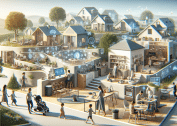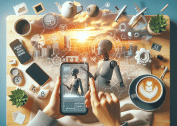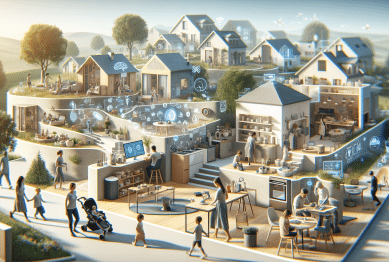In the dynamic, tech-driven world of 2025, where hybrid work models, AI tools, and global collaboration define professional environments, creativity is a vital driver of innovation, problem-solving, and workplace success. By fostering original thinking and adaptability, creativity transforms modern workspaces, enabling teams to navigate challenges and seize opportunities. This article explores the role of creativity in contemporary work settings, detailing its benefits, practical strategies to cultivate it, and ways to integrate it into daily routines in 2025.

Why Creativity Matters in Modern Workspaces in 2025
Creativity fuels innovation, differentiates businesses, and enhances employee engagement in an era of rapid change. In 2025, with AI automating routine tasks and remote work reshaping collaboration, creative thinking empowers workers to solve complex problems, adapt to market shifts, and create value in competitive industries. By prioritizing creativity, organizations and individuals can thrive in flexible, technology-rich workspaces.
Key Benefits of Creativity in Modern Workspaces
Fostering creativity in the workplace offers significant advantages for teams and individuals:
1. Drives Innovation
Creative thinking sparks new ideas, products, and processes that keep organizations competitive.
- How It Works: Encouraging diverse perspectives leads to innovative solutions for business challenges.
- Real-Life Impact: A marketing team brainstorms a unique campaign using AR technology, boosting brand engagement.
- Tip: Schedule regular brainstorming sessions to generate fresh ideas.
2. Enhances Problem-Solving
Creativity enables teams to tackle complex issues with unconventional approaches.
- How It Works: Flexible thinking allows employees to find solutions beyond traditional methods.
- Real-Life Impact: A developer uses creative coding techniques to streamline a software issue, saving project time.
- Tip: Practice lateral thinking exercises to approach problems from new angles.
3. Boosts Employee Engagement
A creative work environment fosters motivation and job satisfaction.
- How It Works: Opportunities for creative expression make work more fulfilling and reduce burnout.
- Real-Life Impact: A designer given freedom to experiment with projects feels more invested in their role.
- Tip: Allow employees autonomy in how they approach tasks to spark enthusiasm.
4. Supports Adaptability
Creativity equips teams to pivot quickly in response to change or disruption.
- How It Works: Creative mindsets embrace uncertainty, finding opportunities in shifting conditions.
- Real-Life Impact: A remote team reimagines virtual collaboration tools to maintain productivity during a tech outage.
- Tip: Encourage experimentation with new tools or workflows to build flexibility.
Practical Strategies to Cultivate Creativity in Workspaces
Here’s how to foster creativity in modern workspaces, whether in-person, remote, or hybrid:
1. Create a Collaborative Environment
Encourage open communication and diverse perspectives to spark creative ideas.
- How to Do It: Use platforms like Slack or Microsoft Teams for idea-sharing and host virtual or in-person brainstorming sessions with cross-functional teams.
- Why It Helps: Collaboration exposes employees to varied viewpoints, fueling innovation.
- Tip: Rotate team roles in meetings to encourage fresh input from all members.
2. Design Inspiring Workspaces
Craft physical or virtual spaces that stimulate creative thinking.
- How to Do It: For in-person settings, add plants, art, or flexible seating; for remote work, use virtual backgrounds or tools like Miro for visual collaboration.
- Why It Helps: Inspiring environments boost mood and creative output.
- Tip: Experiment with ambient music or lighting (e.g., Philips Hue) to enhance focus.
3. Leverage Technology for Creativity
Use AI and digital tools to augment creative processes and ideation.
- How to Do It: Employ AI tools like Grok 3 for generating ideas or Canva for quick design prototyping, streamlining creative workflows.
- Why It Helps: Technology amplifies creativity by automating routine tasks and offering new mediums.
- Tip: Try one new creative tool, like Figma, to explore innovative project approaches.
4. Encourage Time for Exploration
Allocate time for employees to experiment and pursue passion projects.
- How to Do It: Implement “innovation hours” (e.g., 10% of work time) for exploring new ideas or side projects, inspired by Google’s 20% time model.
- Why It Helps: Free exploration fosters breakthrough ideas without pressure.
- Tip: Set clear goals for innovation time to balance creativity with productivity.
5. Promote a Growth Mindset
Foster a culture that views challenges as opportunities for creative growth.
- How to Do It: Encourage learning from failures through post-project reviews and celebrate creative risks, using tools like Notion to document lessons.
- Why It Helps: A growth mindset reduces fear of failure, unlocking bold ideas.
- Tip: Share success stories of creative solutions to inspire teams.
6. Review Creative Output Monthly
Spend 15–20 minutes monthly assessing how creativity impacts projects and workflows.
- How to Do It: Evaluate new ideas implemented, team engagement, or project outcomes, adjusting strategies to enhance creative culture.
- Why It Helps: Regular reviews ensure creativity aligns with organizational goals.
- Tip: Use feedback tools like SurveyMonkey to gather team insights on creative processes.
Sample Routine for Fostering Creativity at Work
Here’s a routine to integrate creativity into daily and weekly work:
- Daily:
- Morning (5 minutes): Start with a creative prompt or quick sketch to spark ideas.
- Midday (5 minutes): Share one new idea in a team chat or virtual whiteboard.
- Weekly:
- Friday (15 minutes): Host a team brainstorming session or review a creative project’s progress.
- Monthly:
- First Friday (20 minutes): Assess creative contributions and plan new initiatives.
- Quarterly:
- First Friday (30 minutes): Evaluate the impact of creative projects and explore new tools or strategies.
Overcoming Common Creativity Challenges
- Challenge: Lack of time for creative thinking.
Solution: Schedule short, dedicated creativity blocks and use automation to free up time. - Challenge: Fear of judgment or failure.
Solution: Foster a safe environment where all ideas are valued, using anonymous idea submissions if needed. - Challenge: Monotonous routines stifling creativity.
Solution: Introduce variety through new tools, workspaces, or cross-team collaboration.
Tools to Support Creativity in Workspaces
- Collaboration: Slack or Miro for team ideation and communication.
- Design and Prototyping: Canva or Figma for creative project development.
- AI Assistance: Grok 3 for generating ideas or insights.
- Feedback: SurveyMonkey or Google Forms for gathering team input.
- Organization: Notion or Trello for tracking creative projects and goals.
The Bigger Picture: Creativity in 2025 Workspaces
In 2025, creativity is a critical asset in modern workspaces, driving innovation and adaptability in a world of AI automation and hybrid work. By fostering creative environments, leveraging technology, and encouraging exploration, organizations and individuals can unlock new opportunities and stay competitive. Creativity transforms challenges into solutions, making it essential for thriving in dynamic, tech-driven workplaces.
Conclusion: Unleash Creativity for Workplace Success
Creativity plays a pivotal role in modern workspaces, enhancing innovation, problem-solving, and engagement. Foster collaboration, design inspiring spaces, and leverage tools like AI, reviewing creative output regularly to sustain growth. In 2025’s evolving work landscape, these strategies empower teams to excel. Start today, and make creativity a cornerstone of your workspace success.
References:
MIT Sloan. (2025). The Role of Creativity in Modern Teams. https://sloanreview.mit.edu/2025/role-creativity-modern-teams
Forbes. (2025). Why Creativity Is Essential for Workplace Success. https://www.forbes.com/sites/forbesbusinesscouncil/2025/08/15/why-creativity-essential-workplace-success/
Harvard Business Review. (2025). Fostering Creativity in Hybrid Workspaces. https://hbr.org/2025/08/fostering-creativity-hybrid-workspaces
Fast Company. (2025). How to Build a Creative Workplace in 2025. https://www.fastcompany.com/2025/how-build-creative-workplace
Inc. (2025). Creativity as a Competitive Advantage. https://www.inc.com/articles/creativity-competitive-advantage-2025









